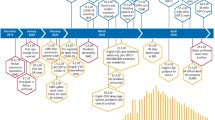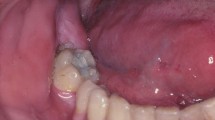Abstract
Aim Aim of this paper was to provide safety and operatory protocols for providing dental care during the COVID19 pandemic.
Data sources The protocol is based on summarising the existing literature, published on different aspects of dealing with the pandemic situation. This protocol was established as an international collaboration among three dental universities: Hadassah School of Dental Medicine Israel, the University of Rochester Medical Centre USA, and the University of Pennsylvania USA. The details of the virus-transmission and its impact on dental care are discussed. Additionally, safety and operatory protocols for urgent and emergency dental care are detailed with a special focus on endodontic and surgical dental care.
Conclusions A protocol detailing the safety and operatory measures to be taken while giving the dental care in the COVID-era is provided. The primary aim is to prevent any cross-contamination while allowing the provision of urgent and emergency dental care. Aerosol-producing and other elective procedures should be avoided.
Similar content being viewed by others
A commentary on
Abramovitz I, Palmon A, Levy D, Karabucak B, Kot-Limon N, Shay B, Kolokythas A, Almoznino G.
Dental care during the coronavirus disease 2019 (COVID-19) outbreak: operatory considerations and clinical aspects. Quintessence Int 2020; 51: 418-429.

GRADE rating
Commentary
Covid-19 pandemic, due to a novel coronavirus (or SARS-CoV-2 Virus) has swamped the whole world and has led to enormous human morbidity and mortality. The virus is known to exhibit a very fast transmission rate and may get transferred from person to person through coughing or sneezing droplets or by touching virus impregnated inanimate objects and subsequently transmitting it to the oro-nasal passage. The clinical symptoms of the disease vary from being totally asymptomatic to having flu-like symptoms which vary from fever, cough etc, to severe pneumonia. Approximately 5% of patients become critically ill or die due to this SARS like disease.1
Dental care providers have been considered to be at high risk of infection due to novel coronavirus, owing to their face-to-face communication with the patients, exposure to saliva and blood during dental treatment, and due to procedures that generate aerosols.2 In order to 'break this chain' of virus transmission it is advised that dentists should act wisely and limit their practices to urgent and emergency procedures only. This will help them to protect themselves, their relatives and also avoid passing of the infection from one patient to another.2 Moreover, these emergency procedures should also be done using stricter measures of safety, personal protection and infection control.
This new situation has made it imperative for the dentists to learn and adopt these newer treatment protocols. This commentary is an attempt to do the same and aims to inform and guide clinicians in the evolution of their practices during this pandemic. The researchers from three different universities from Israel and USA collaborated and have provided an overview on both the safety and operatory protocols that should be followed during this COVID era. Firstly, the authors rightly emphasised usage of tele-consultations. These help to screen patients and minimise avoidable visits to the clinic. Though it is also argued that tele-consultation has its own limitations, including no provision for physical examination, it is recommended that tele-consultation augmented with sharing of photographs should be practiced as first step.3 Further, in accordance with various other published protocols,the authors also urge development of triage, to investigate the patients current health status and presence of risk factors for COVID-19, before dental examination is conducted. It is advised that the triage examination should be based on a standard questionnaire in order to identify patients who might have had any contact with COVID-19 or had a travel history to a COVID affected area. Triage should identify patients with any flu-like symptoms or loss of change in taste. Finally patients should be screened for increased temperatures. The literature suggests that such triage should vary, with different formats of questionnaire, depending on the nature of the outbreak.1 In order to comply with the norms of social distancing as a preventive measure for COVID the authors suggest that there should be no accompanying persons in the dental clinic apart from for minors and disabled patients. It also recommends that waiting areas should have a seating plan with a mandatory separation of patients by 2 m. Also, the waiting areas should always have 70% alcohol based hand rubs while any sharable items like toys, pens, and magazines should be removed.
Further, it is recommended that to protect professional safety, healthcare workers should wear Personal Protection Equipment (PPE) including long sleeved disposable gown, cap, surgical face mask, face shield, protective eye wear and gloves. PPE should be worn for both triage screenings and for any dental procedures. However, as per recommendations, for any aerosol related procedure, an N-95 mask should be preferred over the surgical face mask. The authors also recognise issues concerning the donning, doffing and discarding of PPE, and advise the following of appropriate guidelines to avoid any cross-contamination. On the basis of triage screenings,the authors have arbitrarily categorised patients into three different categories: (1) triage negative (asymptomatic and also negative in questionnaire screening with no fever); (2) triage positive (questionnaire response or temperature screening positive making them potentially COVID positive); and (3) confirmed COVID-19 cases. Confirmed COVID-19 cases have been further categorised as having mild illness and those having respiratory complications. The authors suggest that this type of classification could help ascertain the level of precautions and care to be taken by dentists. It is important, however, to note that since the publication of this paper, it has become clear that grouping people as 'triage negative' when they are asymptomatic and they have had no known contact with COVID-19 patients may be potentially dangerous. Such people might be carriers and hence even the first category of patients should also be managed extremely carefully.
For all categories of patients, the authors recommend focusing on providing only urgent and emergency dental care and deferring elective care. The authors suggest that for category 1 patients, dental treatment might be provided within a dental facility. But for the other two categories (triage positive and COVID confirmed cases) dental treatment should only be performed in a negative pressure room in a medical facility. Owing to associated medical complications due to COVID-19, it is advised that for both these categories of patients, the treatment plan should be made in accordance with medical consultation, taking into account the patient's physical condition and presence of any co-morbidities. In case of any unstable respiratory symptoms the authors recommend deferring even emergency procedures and considering the use of pharmacological agents for symptomatic relief. The authors say that in addition to familiarising themselves with this way of categorising patients, it is also important to understand that the basics of dental care should be amended. For example extra-oral radiography techniques should be used and if intra-oral radiographs are absolutely essential, sensors should be protected with disposable barriers, and all other paraphernalia should be properly heat sterilised and disinfected.4 Secondly, emergency dental care will mostly involve local anaesthesia administration, which should be given with all precautions to avoid the needle contact and using the one-handed scoop technique for recapping the needles. Use of inhalation sedation should be avoided for patients with COVID-19 and all other URTIs symptoms. The authors claim that such measures would help to avoid virus transmission through the dental operatory and will minimise the occurrence of any medical complications.
To define the conditions that require urgent and emergency dental care, the authors have rightly used the ADA classification and accordingly, a dental emergency is a situation which is potentially life-threatening due to airway obstruction, ongoing tissue bleeding etc, while urgent dental care is needed for situations with severe pain or infection. The authors focus broadly on these conditions and how to deal with endodontic and maxillo-facial emergencies; however, these principles could be modified and adapted for providing care in other dental specialities. The paper provides easy-to-understand flow-charts summarising the clinical and other endodontic situations that would demand urgent care. These flow-charts also provide guidance about the treatment procedures that can be carried out during this pandemic. Prior to providing dental treatment, a prophylactic mouth rinse with 1% H2O2 or 0.2% povidone-iodine has been recommended to decrease any viral load, but the evidence for the effectiveness of this is not presented. The authors warn against the use of microscopes and loupes, as they are incompatible with PPEs and are not required for minimal invasive procedures. For endodontic emergencies, which may include pulpal inflammations, abscess etc, initially, and as normal, a diagnosis should be established to ascertain the cause and treatment required. For symptomatic irreversible pulpitis the authors advise that puloptomy can be performed with precautions, in a dental clinic or a medical set-up, depending on the category of patients. For access opening, the authors advised to prefer using a low-speed hand piece and if a high-speed hand piece is essential, headpieces with anti-retraction valves should be used. Sodium hypochlorite solution is the preferred irrigant owing to its virucidal properties. In case of peri-apical involvement, root-canal debridement followed by dressing and a temporary filling with dis-occlusion of the tooth has been advised while for an abscessed tooth I&D should be done as an emergency procedure. A previously root-canal treated tooth should be de-obturated, if possible, while antibiotics and analgesics should be given for other cases for providing symptomatic relief. The intent is obvious; providing pain relief while avoiding the chance of virus transmission and to buy time until elective and permanent care can be provided.
Further for endo-perio lesions similar principles are advocated. However, for any of the above situations if a tooth is judged to have a questionable prognosis, including the teeth with vertical root factures, the authors advise extraction of the offending tooth. Similarly for all oral surgery procedures, only emergency and urgent operations should be performed and this should be done in medical facility and any aerosol-producing and other elective procedures should be avoided. The safety and operatory protocols, as summarised by the authors, seem exhaustive and should be adapted by dentists if they are providing dental care for urgent and emergency situations in this COVID-era. These 'suggestive guidelines' may change in the coming days owing to changing patterns of the disease, newer treatments emerging against the virus, and reports from upcoming trials investigating the efficacy of safety and treatment protocols in the dental operatory. Hence, in the COVID-era it has become imperative for dentists to keep themselves updated with the newest evidence-based guidelines, which are being revised faster than ever before.
References
Izzetti R, Nisi M, Gabriele M, Graziani F. COVID-19 Transmission in Dental Practice: Brief Review of Preventive Measures in Italy. J Dent Res 2020; DOI: 10.1177/0022034520920580.
Wadia R. Transmission routes of COVID-19 in the dental practice. Br Dent J 2020; 228: 595.
Maret D, Peters OA, Vaysse F, Vigarios E. Integration of telemedicine into the public health response to COVID-19 must include dentists. Int Endod J 2020; 53: 880-881.
4. Dave M, Coulthard P, Patel N, Seoudi N, Horner K. Letter to the Editor: Use of Dental Radiography in the COVID-19 Pandemic. J Dent Res 2020; DOI: 10.1177/0022034520923323.
Author information
Authors and Affiliations
Rights and permissions
About this article
Cite this article
Gugnani, N., Gugnani, S. Safety protocols for dental practices in the COVID-19 era. Evid Based Dent 21, 56–57 (2020). https://doi.org/10.1038/s41432-020-0094-6
Published:
Issue Date:
DOI: https://doi.org/10.1038/s41432-020-0094-6
This article is cited by
-
Do aspirating systems have a role in preventing COVID-19 transmission among dental healthcare workers?
Evidence-Based Dentistry (2021)



